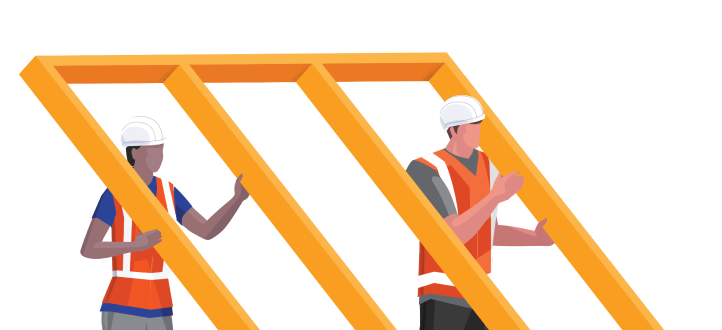— 4 min read
Calculating Cost of Goods Sold for Construction Contractors
Last Updated Dec 18, 2023

Cost of goods sold (COGS) makes up a substantial portion of a construction company’s expenses. Most purchases are related to projects, either for labor or materials. Tracking these costs and keeping them separate from regular business expenses is key when it comes to measuring job profitability.
Table of contents
What is cost of goods sold in construction?
Generally, “cost of goods sold” or COGS is the sum of expenses required in the production of a product. For construction contractors, COGS includes any costs that are associated with the performance and completion of a project. Depending on the accounting software used and the way the chart of accounts is set up, companies may call these “project costs,” “job costs,” or “construction costs.”
On a construction company’s financial statements, COGS is subtracted from total revenue to calculate gross profit margin. This metric can be computed for a specific project to analyze its profitability, or it can be based on a company’s overall sales and costs to show profitability during a specific period.
What types of costs are included in COGS?
Two types of costs are included when calculating COGS in construction: direct costs and indirect costs. In many industries, the cost of goods sold only includes expenditures directly associated with production of goods. But construction companies incur other costs during the course of a project that are often attributable to a specific project.
Direct costs, or hard costs, are costs that are related to performing work required to complete a project. They include materials, subcontractors, wages for labor, and other expenses.
For example, direct costs include material purchases, subcontractor payments, wages for employee labor, and equipment rental fees. All of these are considered direct job costs and are included in the cost of goods sold.
Indirect costs, or soft costs, are expenditures not directly related to construction. These may include vehicle expenses like gas and maintenance, phones, business insurance, and payroll burden (the employer-paid portion of payroll taxes and benefits).
Soft costs not included in the cost of goods sold are recorded as overhead costs.

How to calculate COGS in construction
Once you’ve decided which soft costs to include, add up all the project-related direct costs and the indirect costs you have identified. Other overhead costs and business taxes are not included.
Contractors usually break out their COGS in a job costing report so they can track project profitability and compare costs to their estimate for a specific project. Most accounting software for construction can generate this type of report automatically.
Contractor tips for calculating cost of goods sold
- Set up your accounting software and the chart of accounts to track cost of goods sold. You may want to set up multiple general ledger accounts for these costs to keep things organized.
- Set up your accounting software to track job costs. This helps with project profitability reporting and comparing project costs to original estimates.
- Break down your COGS general ledger accounts by cost type. This means you’ll have separate COGS accounts in your chart of accounts for material, labor, labor burden, subcontractors, and other costs. Doing this helps reconcile accounts at month-end and makes insurance audits easier, as you can quickly generate a report on the expenditures on each cost type.
- Make sure to code all job expenses to the project. If an employee is on a job for several months, the cost of their phone and vehicle expenses for that time period should generally be costed to that project, rather than the overhead account.
- Check with an accountant to ensure expenses are being recorded and coded correctly. There could be different tax treatment for project expenses on certain types of projects, potentially impacting tax liability.
Free e-book
The Keys to Success in Commercial Construction
Learn the financial strategies and business practices that lead to positive cash flow and long-term growth.

Categories:
Tags:
Written by
Dawn Killough
33 articles
Dawn Killough is a writer with over 20 years of experience in construction, having worked as a staff accountant, green building advisor, project assistant, and contract administrator. She shares fundamental green building strategies and techniques in her book, Green Building Design 101. Dawn lives in Portland, Oregon.
View profileReviewed by
Ryan O'Donnell
Ryan O'Donnell works at Procore as Senior Product Manager, Financials. He has spent his career working in construction finance -- including roles as Controller & CFO for Terminal Construction Corporation in NYC, AVP of Commercial Real Estate at M&T Bank, and Senior Auditor for Kiewit Infrastructure Group. Ryan earned his MBA in Accounting & Finance from Rutgers University. He lives in New York.
View profileWin More Work
Get discovered for relevant work on the Procore Construction Network.

Explore more helpful resources

Work in Progress (WIP) Accounting: What Is It and Why Is It Important?
Work in progress (WIP) accounting is a method of accounting tailored specifically to construction that tracks costs and revenues throughout the lifecycle of construction projects. Rather than waiting for project...

The Role and Relevance of the Construction General Ledger
The general ledger is a comprehensive record of a company’s financial activity. In the construction industry, the general ledger plays a critical role in tracking and assessing a firm’s financial...

6 Tips to Boost Contractor Profit and Reduce Overhead in Construction
The average net profit margin for construction businesses ranges from just 3-7 percent, according to research from IBIS World. In order to make a profit, construction businesses need to account...

Introduction to Construction Accounting
Construction companies have to make difficult choices among many financial alternatives, like bidding on one project over another, selecting financing for materials or equipment, or setting a project’s profit margin....
